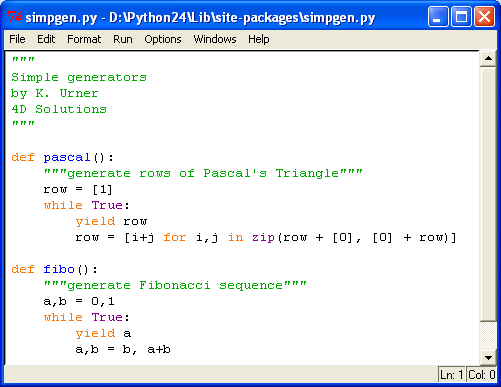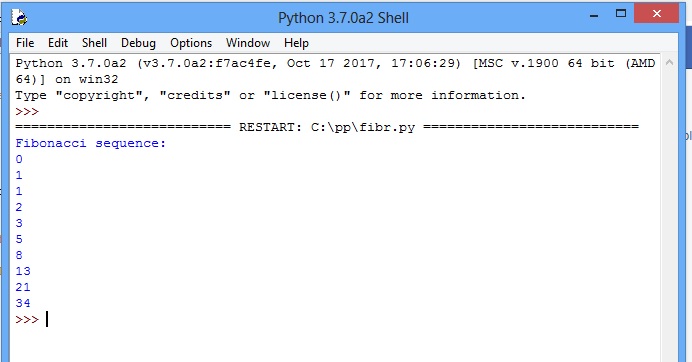

Each time the while loop runs, our code iterates. This approach uses a “ while” loop which calculates the next number in the list until a particular condition is met. Let’s start by talking about the iterative approach to implementing the Fibonacci series.

Python Fibonacci Sequence: Iterative Approach The rule for calculating the next number in the sequence is: It keeps going forever until you stop calculating new numbers.

Each number is the product of the previous two numbers in the sequence.
FIBONACCI SEQUENCE PYTHON SERIES
The Fibonacci Sequence is a series of numbers. We’ll look at two approaches you can use to implement the Fibonacci Sequence: iterative and recursive.
FIBONACCI SEQUENCE PYTHON HOW TO
In this guide, we’re going to talk about how to code the Fibonacci Sequence in Python. Access exclusive scholarships and prep coursesīy continuing you agree to our Terms of Service and Privacy Policy, and you consent to receive offers and opportunities from Career Karma by telephone, text message, and email.Career Karma matches you with top tech bootcamps.The _getitem_ method need to returns an element based on a given index or raise an Inde圎rror if the index is out of bounds.Implement the _len_ and _getitem_ method to define a custom sequence.Output: Code language: JSON / JSON with Comments ( json ) Summary

Print(fibonacci) Code language: Python ( python ) Now, you can slice the Fibonacci sequence as follows: from fibonacci import Fibonacci Return 1 return Fibonacci.fib(n -2) + Fibonacci.fib(n -1) Code language: Python ( python ) Return [Fibonacci.fib(k) for k in def fib (n): if n < 2: from functools import lru_cacheĭef _getitem_ (self, index): if isinstance(index, int): Otherwise, it returns the Fibonacci number of the index. The _getitem_ method raises the Inde圎rror exception if the index is out of bounds. The _getitem_ checks if the index is integer by using the isinstance function. The _getitem_ method accepts an index which is an integer. Return Fibonacci.fib(index) Code language: Python ( python ) To calculate a Fibonacci number in Python, you define a recursive function as follows: def fib (n): if n self.n - 1: īut we’ll stick with the original Fibonacci sequence that starts at one. Some sources state that the Fibonacci sequence starts at zero, not 1 like this: 0, 1, 1, 2, 3, 5, 8, 13, 21. The following formula describes the Fibonacci sequence: f(1) = 1 In the Fibonacci sequence, each number is the sum of two numbers that precede it. The Fibonacci sequence was first discovered by Leonardo Fibonacci, who is an Italian mathematician, around A.D. If a custom sequence has the _len_ method, you can use the built-in len function to get the number of elements from the sequence. If the index is out of bounds, the _getitem_ method should raise an Inde圎rror exception.Īlso, the _getitem_ method can accept a slice object to support slicing. The range of the index should be from zero to length - 1. The _getitem_ should return an element from the sequence based on the specified index. The _getitem_ method has the index argument which is an integer. _len_ – returns the length of the sequence._getitem_ – returns an element at a given index.Technically, a custom sequence type needs to implement the following methods: Iterate over the elements of the sequence using the for loop, comprehension, etc.Use the square brackets syntax to retrieve an element by an index.If an object can fullfil the above requirements, then you can: Return an element at a given index or raise an Inde圎rror if the index is out of bounds.Technically, this requirement is not necessary. Return the number of elements of the sequence.In this tutorial, you’ll focus on defining a custom immutable sequence type.īasically, an immutable sequence type should support two main functions: Sometimes, it’s useful to implement a custom sequence type that has functions similar to the built-in sequence type like tuples and lists.Īs you’ve learned so far, a sequence can be mutable or immutable. Introduction to the custom Sequence type in Python Summary: in this tutorial, you’ll learn how to define a custom Sequence type in Python and how to implement the Fibonacci sequence using a custom Sequence type.


 0 kommentar(er)
0 kommentar(er)
